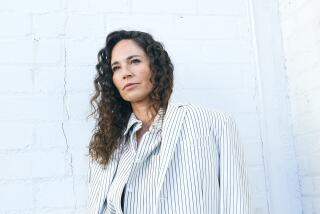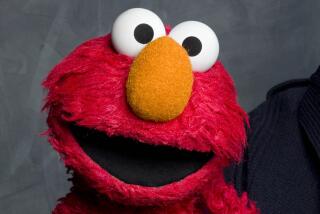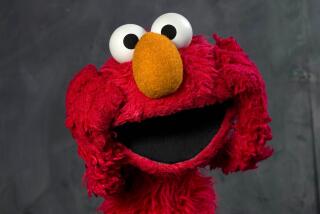Life on the ‘Street’ : Caroll Spinney Has Been Big Bird and Oscar the Grouch for 26 Years. And He Still Loves It.
QUEENS, N.Y. — Someone didn’t get his lines right, and Oscar the Grouch is, well, a bit grouchy. He rests his churlish chin grouchily on his left arm and drums the fingers of his right on the shelf of the newsstand he is tending. Around the newsstand hang such magazines as Lice and Smug and several copies of the Grouchy News.
It’s another hectic day at the “Sesame Street” studios, which means Oscar doesn’t have much time to be grouchy. Few real-life people around here are, especially the jolly graying elf popping up behind the newsstand, one hand still sheathed with Oscar.
Caroll Spinney wears half-glasses, and his face is surrounded by near-white pageboy-style hair and a full beard. He, like many of the two dozen Muppeteers, producers and technicians on the set, wears a “Sesame Street” T-shirt with a slew of smiling characters on it.
“It’s always been a great place to work. There isn’t a day I’m supposed to be there that I don’t want to go,” said Spinney, 61, who, for the past 26 years has been the man behind--or, actually, in--both Oscar the Grouch and Big Bird.
Spinney finds little contradiction in playing both Oscar, arguably the most negative character on the world’s most revered children’s show, and Big Bird, its most beloved.
“It’s fun to play both characters. It’s really therapeutic,” he said. “Oscar can tell anybody anything. Some days, as Oscar, I’ve been so awful, I wouldn’t walk across the street to talk to me. But I imagine he represents (the idea) that it takes all kinds to make up the world.”
But it is as the 8-foot-tall lumbering, naive and very yellow Big Bird that Spinney has made his greatest mark. The ever-childlike Big Bird is the show’s most popular character, seen and adored in 130 countries and seven languages.
“We just couldn’t take Big Bird off the air,” “Sesame Street” executive producer Michael Loman said. “Big Bird is used more than any other Muppet on the show. Big Bird is sort of like Everykid. He can mess up and that is OK. He shows that it doesn’t matter if things are not perfect, that you can always try again. And that is as true today as it was 25 years ago.”
Back in the year 1 BBB (Before Big Bird), or 1969 in adult years, Spinney booked himself in to do what he thought would be a new kind of multimedia performance at the Puppeteers of America Festival. He was planning to use his own animated films in conjunction with his puppets. The result was a disaster.
“They had students on the crew who knew nothing about lighting, and you couldn’t really see the animation on the screen properly. My desperation at trying to get the lighting fixed was funnier than my material,” said Spinney, whose full-time job at that point was playing Bozo the Clown’s sidekick on a Boston kids’ TV show.
*
Fortunately, there was someone in the audience that day who got the gist of Spinney’s effort.
“Jim Henson,” the late creator of the Muppets, “was in the audience and came backstage. He said, ‘I liked what you were trying to do.’ He said he was working on a new children’s show and was going to build this large bird which I would be perfect for,” Spinney recalled.
“I always said that it was the equivalent of this little band from Liverpool coming by and saying they wanted me to be their drummer,” he said with a hearty Big Bird laugh.
Spinney grew up in Acton, Mass., now a Boston suburb but back in the 1940s a rural community about 30 miles west of the city. When he was 8, his mother, who had grown up in England adoring Punch & Judy shows, built him a puppet theater and then, over the years, wrote 12 different shows for him. He attended the Art Institute of Boston, torn between whether to become a puppeteer or an illustrator.
“But you can’t get any applause when you draw, so puppets it was,” he said.
Spinney winces when he thinks of the first “Sesame Street” shows.
“It was so crude. There was so much to learn. The costumes were such that often I couldn’t see what I was doing, and we rarely got to see (videotape) playback. You can only look back and say, ‘How come they thought it was so good?’ ”
“Sesame Street” is produced five months a year, from August until January, in the old Astoria Studios in Queens in New York City, a half-dozen subway stops from the bustle of Manhattan, where it was headquartered for its first 24 years. When it moved to the larger quarters at Astoria, where Woody Allen shoots many of his films, it also expanded the mythical “street,” adding a park, a few stores and several live and Muppet characters. But Big Bird still appears as often as he always has, in about half the live scenes.
Whereas he feels little has changed for Big Bird or Oscar over the years, much has changed for the man who plays them. In the early years, he, Henson and Frank Oz were the only “Sesame Street” puppeteers, so he did many more characters. Money was tight then too, and he continued to do his own puppet shows at schools and festivals.
Now, with extra dollars coming in for personal appearances as Big Bird, Spinney said, he pretty much works only five or six months a year, doing a lot of traveling with his wife, Debra, the rest of the time. (Neither Spinney nor Children’s Television Workshop, which produces “Sesame Street,” would divulge Spinney’s salary.) And unlike most world-famous celebrities, he gets to do it pretty much without fanfare.
“I’m rarely recognized, and I never did try to get in publicity pictures as myself, since I like my privacy,” Spinney said. “I recently heard somewhere that Big Bird was the most recognized children’s character, so I guess I must be the most famous unknown person, and I like it that way.”
Although there are limited tours of the “Sesame Street” set, no children under 4 are allowed. (“We like to keep the illusion that the Muppets are real for little children,” a “Sesame Street” spokeswoman said.) Whenever Spinney, as Big Bird, does appearances, he stays in character, never lifting off his solid top half in public.
*
In the Big Bird suit, Spinney’s right hand stays over his head, operating the beak, and his left arm in the Bird’s left wing. The right arm is attached to the body by a near-invisible string, moving only as his body moves. It can be quite an exhausting process on a long out-of-studio appearance, such as the one on a 100-degree-day last summer when Big Bird threw out the first ball at a Yankees-Orioles game, or getting a star on the Hollywood Walk of Fame last April.
After all this time, Spinney still revels in being able to perpetuate the Big Bird myth.
“I love it that kids think Big Bird is a person like them. I have a young grandson, Wyatt, and he still thinks Big Bird lives in my house,” Spinney said. “I hope I can do this for a long, long time.”
More to Read
The complete guide to home viewing
Get Screen Gab for everything about the TV shows and streaming movies everyone’s talking about.
You may occasionally receive promotional content from the Los Angeles Times.






